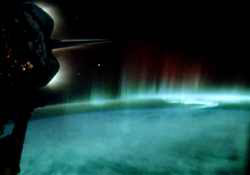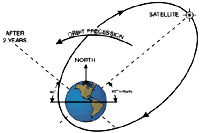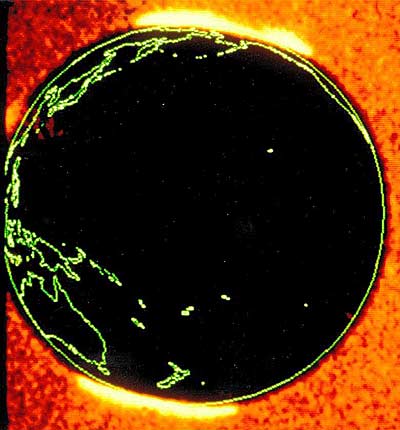Space Weather

An aurora over Australia as seen from the space shuttle, whose tail is visible at the top left. (photo courtesy of NASA)
How's the space weather today? Quiet enough for a safe trip to the moon? Quiet enough to operate your GPS navigation system accurately? So active that it would crash your power grid? Like our everyday weather, space weather can change suddenly, become violent, and interfere with our lives.
Space weather is driven by the sun. The solar wind, a plasma of protons and electrons, streams out of the sun and changes the shape of Earth's magnetic field.
Near Earth's surface, this field is like the field of a giant bar magnet, as shown.
Investigating the Magnetosphere
To study the magnetosphere, space physicists send instruments into orbit. In the past, multi-purpose satellites contained sensors that took samples of charged particles and electric and magnetic fields, but the sampling was limited to the satellite's orbit. NASA's Imager for Magnetopause-to-Aurora Global Exploration (IMAGE), launched in March, 2000, is the first satellite dedicated to investigating the magnetosphere using remote sensing instruments. Its orbit (see diagram) takes it high above the North Pole in order to produce images of plasmas that show the entire inner magnetosphere at once.

Orbit of the Imager satellite; over its the two-year lifetime, the axis of the orbit swings between the two dotted lines shown, giving the instruments different views of the inner magnetosphere. (image courtesy of NASA)

The IMAGE satellite; the axis of the satellite goes from left to right in this drawing; the extraordinarily long antennas are perpendicular to this axis. (drawing courtesy of NASA)
IMAGE employs two colossal antennas 500 meters across, longer than the height of the Empire State Building, making IMAGE the longest structure in orbit (see drawing of satellite). These antennas are actually part of a radar system that sends out radio waves, which reflect from regions of higher plasma density than at the satellite and thus enable physicists to map the plasma concentration throughout the inner magnetosphere.
IMAGE discovered a feature of the magnetosphere that had been predicted in the 1970s but never before observed globally, a plasma "tail" streaming back toward the sun from Earth. The blue image shows this tail, which curls back towards the sun as the solar wind sweeps around the boundary of the magnetosphere.
IMAGE also detected extreme ultraviolet light emitted by neutral helium atoms, which have absorbed energy from the plasma. The red image (in false color) shows this glow, which provides information about the how the magnetosphere changes during magnetic storms.
The IMAGE science team places data on the Internet, available to all, one day after acquisition. Moreover, all data and even analysis are available at the National Space Science Data Center. This free sharing of experimental results is of special importance since most space scientists must rely on large-scale projects like IMAGE for data.
Links
Rice University
NASA
NASA-sponsored
Space Science Institute

Auroras, the bright regions at the top and the bottom of the image, at both the North and South Pole (image courtesy of NASA)














